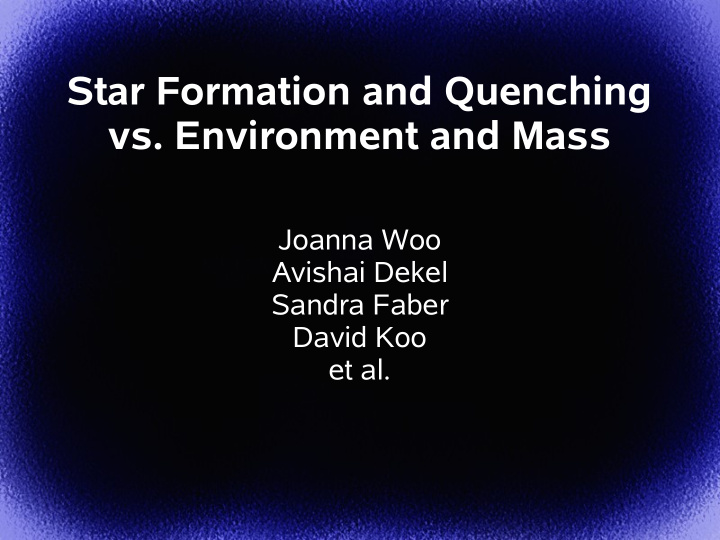



Star Formation and Quenching vs. Environment and Mass Joanna Woo Avishai Dekel Sandra Faber David Koo et al.
Goals ● Study relations between δ Ν , Μ * , Μ h at z ~0, z ~1: – Splitting centrals and satellites – Using dual mode understanding of δ N ● Multi-halo mode, single-halo mode ● Study quenching vs. δ Ν , Μ * , Μ h – Centrals vs. satellites, single halo/ multi halo mode ● Results: – M h dominates quenching – Other kinds of quenching: small deviations
Two modes of δ N δ N mode depends on: -N (SDSS: N=5) -mag limit -z Cooper et al (2005) Cooper et al (2005) Kauffmann etal (2003) Kauffmann etal (2003)
δ N also measures proximity to halo centre Close to centre Far from Cooper et al (2005) centre (references for data labelled beside all axes) Yang et al (2007) (Only for groups with more than 5 members)
Relations between δ Ν , Μ * , Μ h : Centrals Single halo Cooper et al (2005) Multi-halo Yang et al (2007) Yang et al (2007) Shock scale ~ where Expect δ N to correlate with M h relation begins to flatten within halo due to density profile
Relations between δ Ν , Μ * , Μ h : Satellites No big satellites in small halos Single halo Cooper et al (2005) Kauffmann etal (2003) Multi-halo δ N correlates with M h also because of density profile
SFR Sequence SDSS What’s a “star-forming” galaxy? -on the SFR sequence What’s a “quenched” galaxy? - >2σ below SFR sequence The “quenched fraction” = quenched / total (weighted by volume and spectroscopic completeness) S a Kauffmann etal (2003) m l i e t a (references for data labelled l ( 2 0 beside all axes) 0 7 )
SFR Sequence vs. Blue Cloud ● How do the BC and RS compare to being on the SFR sequence or below it? ● 31% of the RS lie on the SFR sequence → dusty! ● Only 7% of BC lie below SFR sequence (post- starburst) Blanton & Roweis (2007) The RS is not all quenched! Better to use SFR-M * diagram to distinguish between “star-forming” and “quenched” galaxies.
SFR Sequence vs. Blue Cloud ● How do the BC and RS compare to being on the SFR sequence or below it? ● 31% of the RS lie on the SFR sequence → dusty! ● Only 7% of BC lie below SFR sequence (post- starburst) Blanton & Roweis (2007) The RS is not all quenched! Better to use SFR-M * diagram to distinguish between “star-forming” and “quenched” galaxies.
Quenching vs. δ Ν , Μ * , Μ h : Centrals Main quenching trend σ~0.1dex Secondary details Kauffmann etal (2003) Cooper et al (2005) Main quenching trend Yang et al (2007) Yang et al (2007) σ~0.3dex The dominant trend of quenching is with halo mass, not stellar mass or environment density.
Quenching vs. δ Ν , Μ * , Μ h : Satellites Proximity to centre: -shock heating more efficient -stripping, harrassment, strangulation Single halo Main quenching trend c i r F n y Kauffmann etal (2003) Cooper et al (2005) Multi-halo D Yang et al (2007) Yang et al (2007) Here δ has nothing to do with the halo Incompleteness?
Quenching vs. δ Ν , Μ * , Μ h : Satellites Proximity to centre: -shock heating more efficient -stripping, harrassment, strangulation Single halo Main quenching trend c i r F n y Kauffmann etal (2003) Cooper et al (2005) Multi-halo D Yang et al (2007) Yang et al (2007) Here δ has nothing to do with the halo Incompleteness?
Summary of Results ● The dominant quenching trend for centrals is with halo mass not M * or δ 5 – External quenching – Small dependence on M * and δ 5 : deviation ● The quenching trend for satellites is with both M h and δ 5 in the single halo mode and with M h in the multi-halo mode – External quenching – Small M * trend: consistent with dynamical friction ● Note: these quenching trends with M h show up when measured by the quenched fraction instead of the red fraction ; – Since large SF galaxies are dusty, the red fraction will correlate more with M * than M h causing quenching appear to be internal
Recommend
More recommend